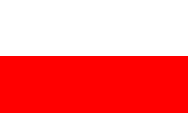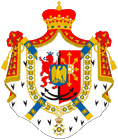Berg |
|
|
|
| Übersicht – Contents: | |
Diese Seite ist Teil des Projektes
Berg |
|
|
|
| Übersicht – Contents: | |
Flagge – Flag: |
|
 |
1806–1813, Landesflagge (Landesfarben) – flag of the country (colours), Quelle/Source nach/by: Wikipedia (D) |
|
|
|
Bedeutung/Ursprung der Flagge – Meaning/Origin of the Flag: |
|
| Die Landesfarben von Berg waren Weiß und Rot. Sie leiten sich vom Wappen des Landes ab, dem silbernen Schild von Berg, dem roten Schild von Kleve. | The colors of Westphalia had been white and red. They are deived from the coat of arms of the country, the red shield of Kleve, the wihte shield for Berg. |
| Quelle/Source: Volker Preuß | |
Wappen – Coat of Arms: |
|
 |
1806–1813, Wappen Großherzogtum Berg – coat of arms the Grand Duchy of Berg, Quelle/Source nach/by: Wikipedia (D) |
Bedeutung/Ursprung des Wappens – Meaning/Origin of the Coat of Arms: |
|
| Das Wappenschild des Großherzogtums Berg zeigt die Heroldsstücke der Länder, die dem Land einverleibt worden waren. Man erkennt: links das Herzogtum Berg (roter Löwe auf Silber), rechts das Herzogtum Kleve (roter Schild). Auf dem Wappenmantel liegt ein napoléonischer Orden, und der Wappenmantel ist mit goldenen Bienen belegt. | The arms
of the Grand Duchy of Berg shows the heraldry of those countries, which had
been incorporated into the country. It can be seen: to the left the Duchy of Berg (red lion on silver), on the right the Duchy of Kleve (red shield). On the crest coat lies a Napoleonic medal, and the coat is covered with golden bees. |
| Die Honigbiene war das persönliche Emblem Napoleon Bonapartes, sozusagen das Wappentier der Person N. Bonaparte, der Adler war das amtliche Wappentier des Kaiseres in (west-)römischer, fränkischer Tradition. Die Vergabe von goldenen Bienen zur Aufnahme in das Wappen war eine speziele Form der Ehrung durch Napoléon für verdienstvolle Personen, Länder oder Städte, so z.B. die Insel Elba. | The honey bee was the personal emblem of Napoleon Bonaparte, so to speak the animal emblem of the person N. Bonaparte, the eagle was the official armor of the emperor in (West-)Roman, Franconian tradition.
The award of golden bees for inclusion into coats of arms was a special form of honoring by Napoléon for meritorious persons, countries or cities, e.g. the island of Elba. |
| Quelle/Source: Volker Preuß, Jürgen Kaltschmitt, nearbees.de | |
|
Lesen Sie hier: Hintergründe, Geschichte und Fakten zum Thema "Der Löwe in der Heraldik". Ausführungen, Varianten, Entwicklung sowie Panther und Leoparden. |
 |
|
|
|
|
|
Zahlen und Fakten – Numbers and Facts: |
|
|
|
|
|
|
|
|
|
|
|
Geschichte: |
|
1792, 1796, 1800 und 1805 · Invasionen französischer
Revolutionstruppen unter Napoléon in das Deutsche
Reich, das Deutsche Reich unterliegt und wird von Napoléon territorial
umgestaltet 1801 · alle linksrheinischen Gebiete werden an Frankreich abgetreten und von diesem einverleibt 1803 · Reichsdeputationshauptschluss, Umgestaltung der territorialen Gliederung des Deutschen Reiches, geistliche Besitzungen werden enteignet, alte Fürstenterritorien und freie Städte werden enteignet oder aufgehoben und alten oder neuen Fürstentümern übertragen, die Zahl der Gebietskörperschaften des Reiches wird dadurch von 300 auf 60 reduziert 15.03.1806 · König Maximilian I. Joseph von Bayern tritt das Herzogtum Berg, und der König von Preußen das Herzogtum Kleve an Napoléon ab, der beide Gebiete zusammenfasst und als Herzogtum Berg (auch Herzogtum Kleve-Berg) an seinen Schwager Murat übergibt 12.07.1806 · Napoléon erzwingt die Gründung des Rheinbundes, ein Zusammenschluss von sechzehn süd- und südwestdeutschen Staaten unter französischem Protektorat, das Herzogtum Berg gehört zu den Gründungsmitgliedern 01.08.1806 · die Staaten des Rheinbunds treten aus dem Heiligen Römischen Reich Deutscher Nation aus, Berg wird Großherzogtum 06.08.1806 · Kaiser Franz II. legt die Krone des Heiligen Römischen Reiches Deutscher Nation nieder, das Reich endet 07.07.1807 · Frieden von Tilsit, Preußen muss große Gebiete an Frankreich abtreten, die zusammen mit anderen Ländereien bis 1808 an das Großherzogtum Berg angeschlossen werden 15.07.1808 · Napoléon ernennt Großherzog Murat zum König von Neapel, und setzt sich selbst als Großherzog von Berg ein (in Personalunion als Kaiser von Frankreich) 03.03.1809 · Napoléon ernennt seinen vierjährigen Neffen Napoléon Louis Bonaparte zum Großherzog von Berg, bleibt jedoch Regent des Landes 13.12.1810 · die Gebiete von Berg nördlich des Flusses Lippe werden von Frankreich annektiert Frühjahr 1813 · antifranzösiche Aufstände werden niedergeschlagen Oktober 1813 · Niederlage Napoléons bei Leipzig, die Franzosen verlassen das Großherzogtum 10.11.1813 · Einmarsch russischer Truppen in Düsseldorf 25.11.1813 · Preußen bildet das Großherzogtum Berg zum Generalgouvernement Berg um, Preußen annektiert das Rheinland 30. April 1815 · Preußen errichtet aus seinen Nordrheinischen Gebieten die Provinz Jülich-Kleve-Berg 22.06.1822 · Preußen vereinigt die Provinzen Jülich-Kleve-Berg und Niederrhein zur Preußischen Rheinprovinz |
History: |
|
1792, 1796, 1800 and 1805 · invasions of French revolutionary
troops under Napoleon in the German Empire, the German Empire subjectes and
becomes territorially transformed 1801 · all left-bank territories of the River Rhine ceded to France, and incorporated by this 1803 · German Mediatisation (Reichsdeputationshauptschluss), transformation of the territorial partition of the German Empire, ecclesiastical possessions become confiscated, old princely territories and free cities become confiscated or dissolved or annexed to old or new principalities, the number of sovereign authorities and territorial entities of the empire is thus reduced from 300 to 60 15th of March in 1806 · King Maximilian I. Joseph of Bavaria cedes the Duchy of Berg, and the King of Prussia cedes the Duchy of Cleves to Napoleon, he summarizes both areas to the Duchy of Berg (also Duchy of Cleves-Berg) and hands it over to his brother-in-law Murat 12th of July in 1806 · Napoleon forces the creation of the Rhine Confederation, an alliance of sixteen southern and southwestern German states under French protectorate, the Duchy of Berg is one of the founding members 1st of August 1806 · the states of the Rhine Confederation declare themselves sovereign and resign from the Holy Roman Empire of German Nation, Berg becomes Grand Duchy 6th of August in 1806 · Emperor Franz II. lays down the crown of the Holy Roman Empire of German Nation, the empire ends 7th of July in 1807 · Peace of Tilsit, Prussia must cede large areas to France, which become annexed together with other lands until 1808 to the Grand Duchy of Berg 15th of July in 1808 · Napoléon appoints Grand Duke Murat to the King of Naples, and sets himself up as Grand Duke of Berg (in personal union as Emperor of France) 3rd of March in 1809 · Napoleon appoints his four years old nephew Louis Napoleon Bonaparte to the Grand Duke of Berg, however, he remains as regent 13th of December in 1810 · the areas of Berg northern the river Lippe become annexed by France Spring 1813 · anti-French riots become precipitated October 1813 · Napoleon's defeat at Leipzig, the French abandone the Grand Duchy 10th of November 1813 · marching-in of Russian troops in Duesseldorf 25th of November in 1813 · Prussia transforms the Grand Duchy of Berg to the Gouvernement General of Berg, Prussia annexes the Rhineland 30th of April in 1815 · Prussia builts from its North Rhine areas the province of Juelich-Cleves-Berg 22nd of June in 1822 · Prussia merges the provinces of Juelich-Cleves-Berg and Lower Rhine to the Prussian Rhine Province |
| Quelle/Source: Wikipedia (D), Discovery '97 |
Ursprung des Landesnamens – Origin of the Country's Name: |
|
| Der Name "Berg" geht auf das Geschlecht der Grafen von Berg zurück, die ihren Stammsitz im 11. Jahrhundert in der Burg Berge bei Altenburg hatten. Die Grafschaft Berg wurde 1380 zum Herzogtum erhoben. 1510 folge die Vereinigung mit dem Herzogtum Jülich zum Herzogtum Jülich-Berg, und 1521 ging das Herzogtum an das Haus Kleve, und es entstand das Herzogtum Jülich-Kleve-Berg. 1609 starb die Linie aus, und Berg kam an die Bayerischen Wittelsbacher. | The name
"Berg" goes back to the family of the Counts of Berg, which were
headquartered in the 11th Century in the Castle Berge at Altenburg. The
county was levied in 1380 to the Duchy of Berg. 1510 followed the union with the Duchy of Juelich the Duchy of Juelich-Berg, and in 1521 the Duchy came to the House of Cleves, and it arised the Duchy of Juelich-Cleves-Berg. In 1609 the lineage vanishes, and Berg came to the Bavarian Wittelsbach dynasty. |
| Quelle/Source: Wikipedia (D) | |